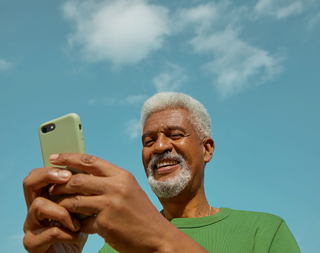Coming out as a person with low vision
The quiet reality of living with visible low vision.


Summary
Using assistive tools like a white cane or screen magnifier can feel like 'coming out' for some people with low vision - revealing a personal condition to the world. While these tools enable independence, they often invite comments or curiosity that can feel intrusive. This article explores the emotional journey of the decision to use assistive tools in public, the importance of understanding and the power of shared experience.
We’ve all been taught not to comment on someone’s appearance. Most of us know this well. But there’s another layer we rarely talk about, the moment someone’s differences become visible. The mobility aid, the assistive technology device, the quiet clue that everyday activities might not unfold as easily for some as they do for others.
That moment can invite attention, often well-meaning, sometimes clumsy, sometimes cruel. For those living with low vision, it can feel a lot like ‘coming out’. You’re revealing a part of yourself to the world that may be very private to you or may not feel like its on your own terms. Many people hold back from sharing their vision loss because of understandable feelings like uncertainty, vulnerability or fear of judgement. Perhaps you are still navigating your own feelings or simply needing more time.
Using assistive technology, utilising a Guide Dog or using a white cane in public may feel like 'wearing your disability on your sleeve' and can attract questions that people with low vision or blindness may not have capacity to answer. The questions or attention often come from a well-meaning curious place but can exhaust the limited energy that the individual has when adjusting to their change in vision. “Sometimes we might not want to share and that’s ok. You are entitled to politely decline the conversation” says SeeWay contributor Bella.
It might be the first time you use a white cane, the day you start using screen magnification or voice prompts on your phone in the supermarket, or the moment you lean on someone’s arm to navigate a busy footpath. Unlike some health conditions that remain non-visible, low vision often becomes public the moment practical tools or assistance come into the picture. And while these tools offer independence and safety, they can also spark questions, or sometimes unsolicited comments.
SeeWay client Charles says "I know people are curious, but I simply tell them I'd prefer not to explain right now". If they ask about my white cane I say "I use it to get around safely and that's all I have to share right now".
“I always felt ‘normal enough’,” says Bella, who has progressive vision loss. “But the first time I used a cane, it changed how people saw me. Suddenly, strangers were asking questions. Friends were curious but awkward. Even family needed time to adjust. It was like I’d 'come out', not by saying anything, but just by being seen.”
For many, that shift is one of the most confronting parts of adapting to life with low vision. It’s not just about navigating footpaths or reading menus; it becomes about navigating other people’s perceptions too.
The comments are often well-meaning, “But you look fine!” or “You seem to be able to see some things well”, but they reveal a gap in understanding. Low vision is personal. It’s not all or nothing. It fluctuates. And for those living with it, the emotional weight of “coming out” publicly, over and over, can be exhausting.
For those in the public, it’s a reminder to pause before making a comment, even one that feels positive. Telling someone they “don’t look blind” or questioning their use of a cane might come from curiosity, but it can undermine their confidence or make an already vulnerable moment feel even harder. Sometimes, offering space, patience, and quiet respect says more than words ever could.
But there is power in being open too, in your own time. It creates space for others to ask questions, to learn, to adjust their assumptions. It also connects people, reminding those with low vision that they aren’t alone, and that community exists.
“Finding other people who were going through the same thing changed everything,” Bella says. “Suddenly I wasn’t explaining myself all the time. I didn’t feel so exposed. It made me realise yes, this is confronting, but it’s also just part of life now. There are others who share the same experience and who are thriving.”
For those still coming to terms with visible low vision, it’s okay to take your time. Whether it’s using a cane, embracing assistive technology, or simply answering questions when you feel ready. Your story, and your pace, are your own.
And when you’re ready, there’s a whole community of people to welcome you.
Your lived experience with vision changes might be exactly what someone else needs to hear. Whether it's a tip, a story or something you've experienced or learnt along the way, if you'd like to share, we'd love to listen. Write or call us at:
Did you find this article helpful?
Share your thoughts and help us make our resources better for everyone.
Enjoying the content?
Start building your profile to access personalised support, resources, and tools tailored to your eye health journey.
